Right now, Arsenal are sitting on top of the Premier League having taken twenty-four points from a possible twenty-seven. They have won eight games and lost just once so far this season, and after securing impressive back-to-back league victories over local rivals Tottenham Hotspur and Liverpool, people are now talking about Mikel Arteta’s men as being the main title challengers to Manchester City.
After narrowly missing on Champions League qualification on the last day of the season, the Gunners’ early season momentum started during pre-season.
They won all five of their pre-season fixtures including impressive 4-0 and 6-0 victories over Chelsea and Sevilla, along with recruiting three key signings in Oleksandr Zinchenko, Fábio Vieira and Gabriel Jesus. Jesus has started the season in fine form scoring five goals.
This scout report will provide an in-depth tactical analysis of Arsenal’s tactics during this campaign and how effective they have been to the start of this season. We will provide an analysis of their attacking approach their attacking threat, and which is supported by their defensive strategy,
Formation

Mikel Arteta has been flexible with his formation choices throughout his time at Arsenal. However, this season has seen the young Spanish manager focus primarily on the 4-2-3-1 and 4-1-4-1 formations.
The reason for focusing on these two formations is that the team can transition fluidly between different attacking shapes in-game allowing Arsenal to adhere to Arteta’s positional play philosophy in possession. Out of possession, it allows the team to be more adaptable against their opposition.
It is the same with the 4-3-3 and 4-4-1-1 formations that have only been used 6% of the time. They have both been used in specific in-match situations to counter the opposition and are both variants of the 4-2-3-1 and 4-1-4-1 formations anyway.
The fluid interchange ensures Arteta’s tactical principles are not compromised.
Positional Play
Arsenal like controlling the game through possession. Mikel Arteta is an advocate of the positional play approach where the team in possession take up positions across the pitch to attempt to create numerical advantages. Arsenal’s attacking players will rotate positions and move from zone to zone in the final third. This movement is triggered by their teammate’s movement and the area the ball is moved. The purpose of this is to disrupt the other team’s defensive shape.
The image below shows the positional set-up from Arsenal as they look to progress possession through each third of the pitch. You can see how there are no more than three players positioned in a line horizontally and how there are not more than two players positioned in a line vertically. This ensures each player has multiple passing options.
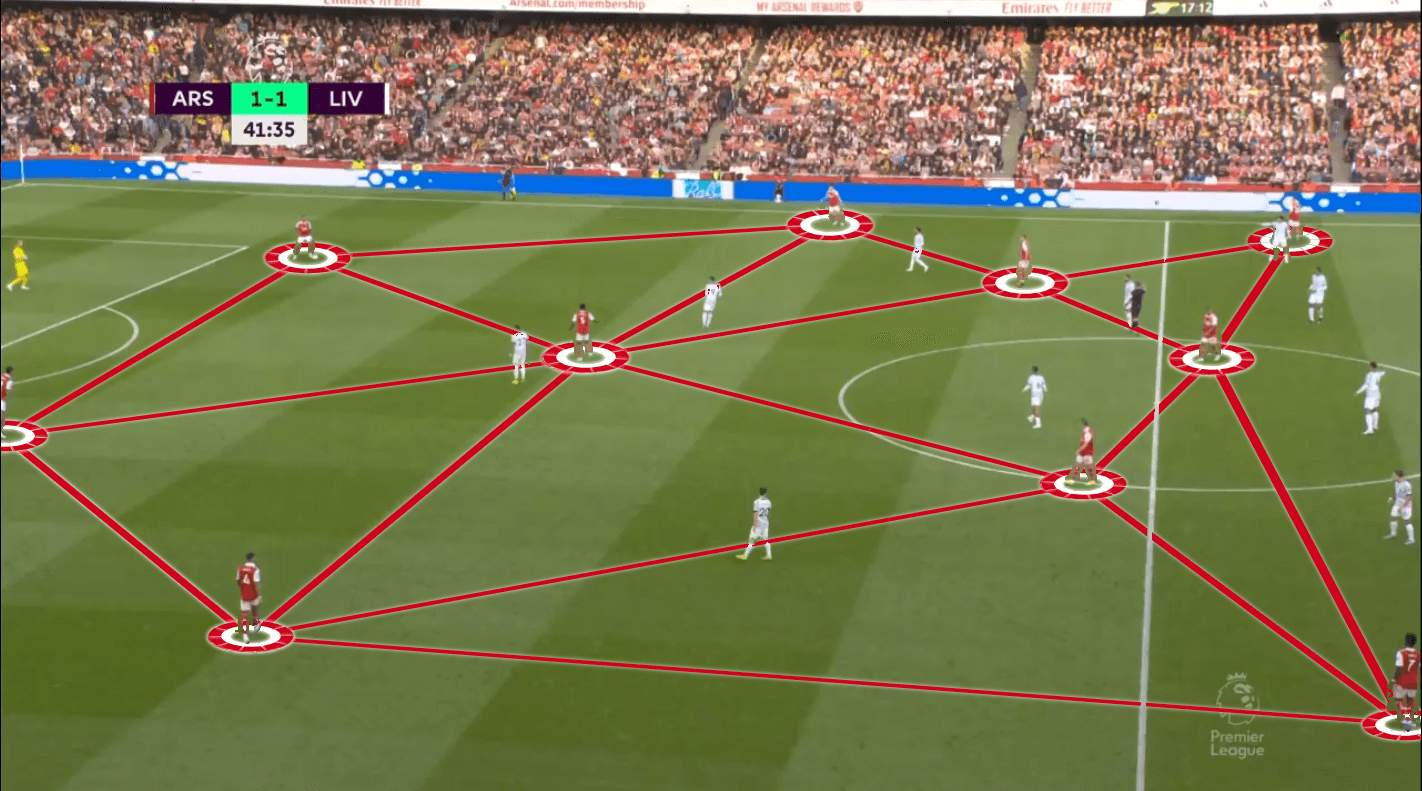
It does not matter what area or zone possession is held, the intention remains the same to create space and multiple passing options for the ball carrier.
Positional play is a tactical principle for teams who control the game by keeping the ball. The concept is that it allows these teams to be progressive and purposeful in possession.
This season Arsenal’s average possession is 57.2 %. This indicates they are keeping possession well. As Arsenal are keeping possession more than their opponents, they have fewer opportunities to counterattack in a match, therefore, to assess how well Arteta’s positional play approach is working, we look at the efficiency of their positional attacks. A positional attack is any attack that is not a counterattack.
The chart below measures how well they are attacking positionally compared to the rest of the Premier League. It shows Arsenal have the highest efficiency with positional attacking.
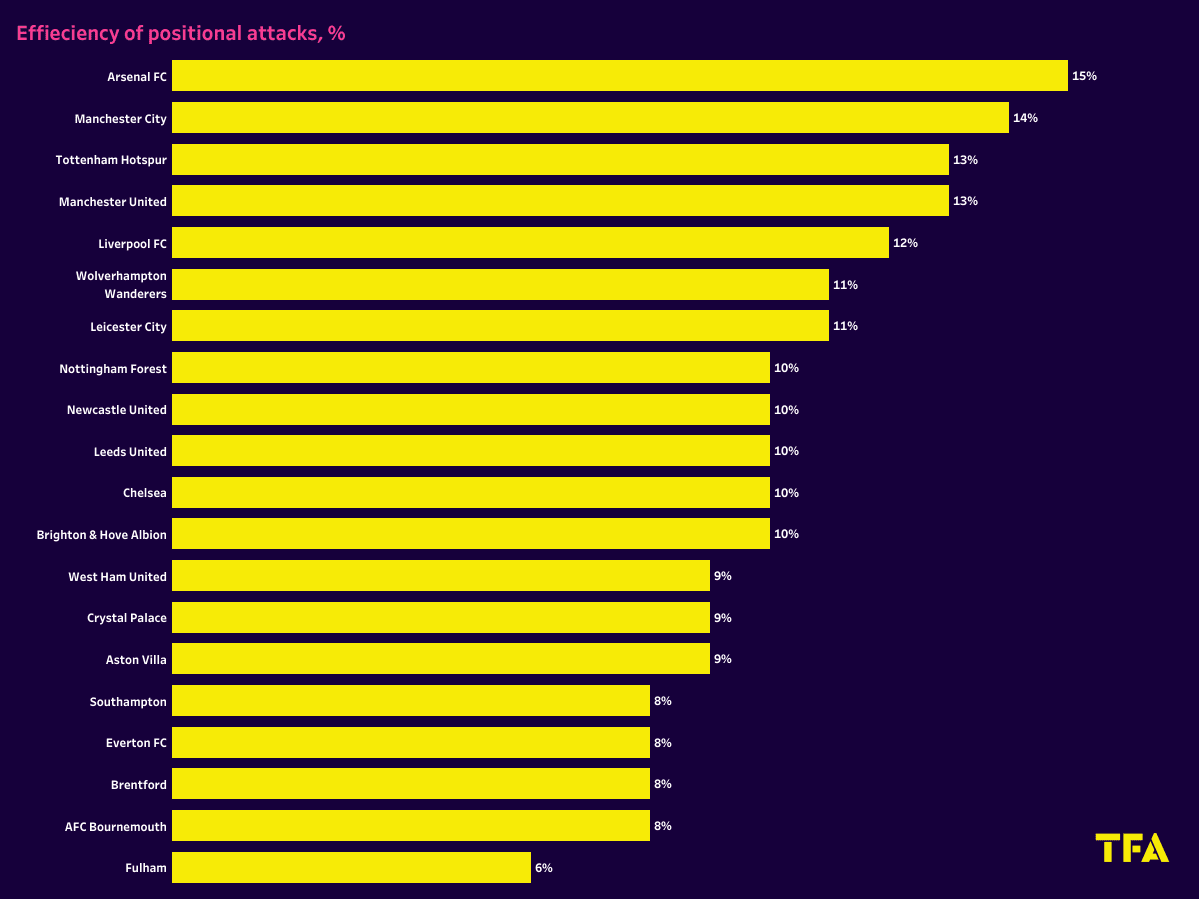
Build-up Stage
Arsenal’s positional play is not just applied in the attacking third, it is applied from the moment the team has possession in open play and starts anywhere on the pitch. The Gunner’s build-up approach plays a key role in how well the team has attacked positionally so far.
This season has seen them show more flexibility with their build-up as the players switch positionally to allow the build-up to be more effective and less one-dimensional.
The image below the full-backs pushing wide during the build-up phase. As well as the full-back providing a progressive outlet, it stretches the opposition’s defensive shape because of the opportunity to create wide overloads against their full-back.
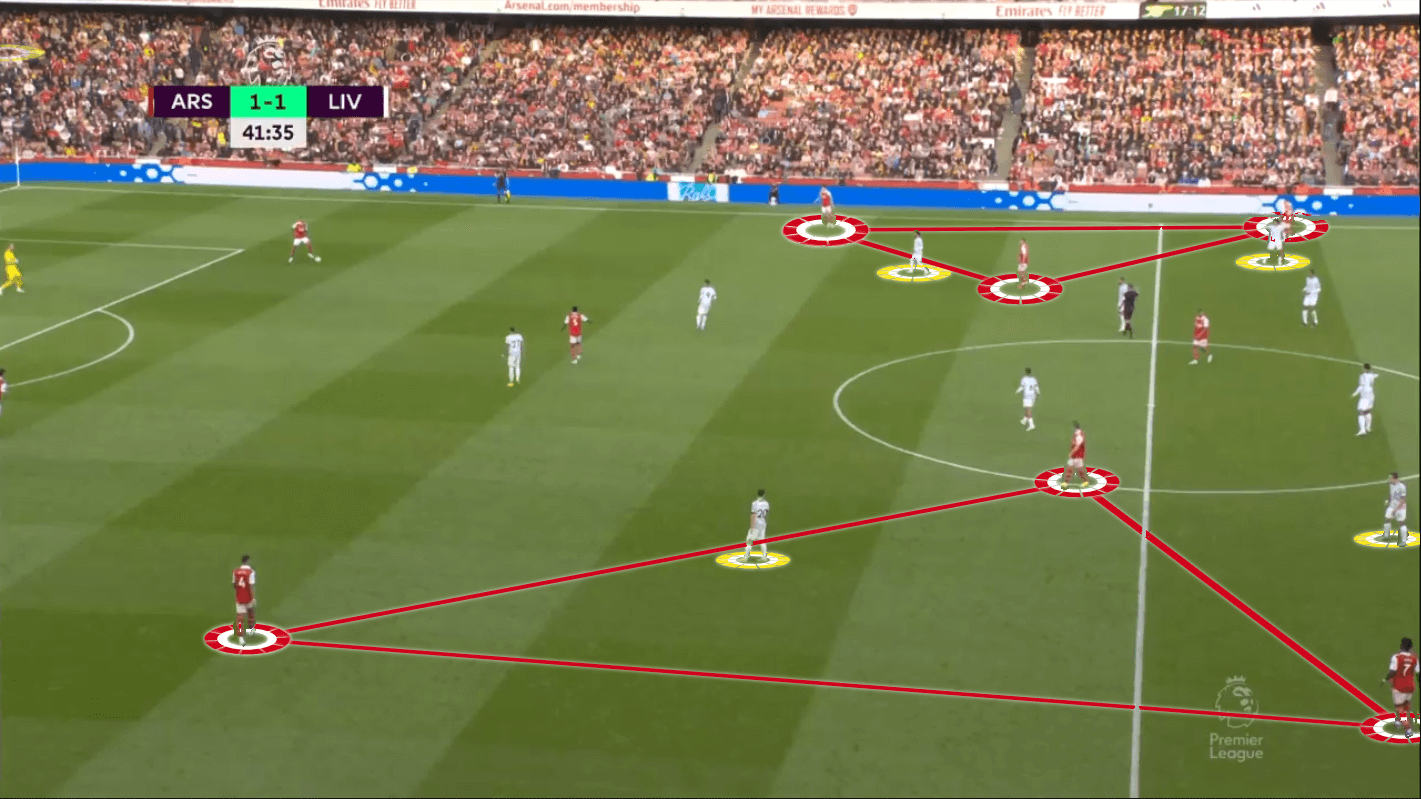
The fullbacks pushing higher and remaining wide present opportunities for wide overloads but a drawback to this is that a well-organised defence can adjust quickly and remain in a narrow and compact shape when they move from side to side. Doing this can halt the vertical progression and central progression as the space between the lines can remain closed. This would force Arsenal’s possession backwards.
An alternative approach used by Arsenal in this phase is, instead of Ben White and Oleksandr Zinchenko sitting in the wide channels positionally, they come inside and sit alongside Thomas Partey in midfield. This forms a 2-3 shape during their build-up.
The 2-3 structure provides them with a more viable option to build up centrally.
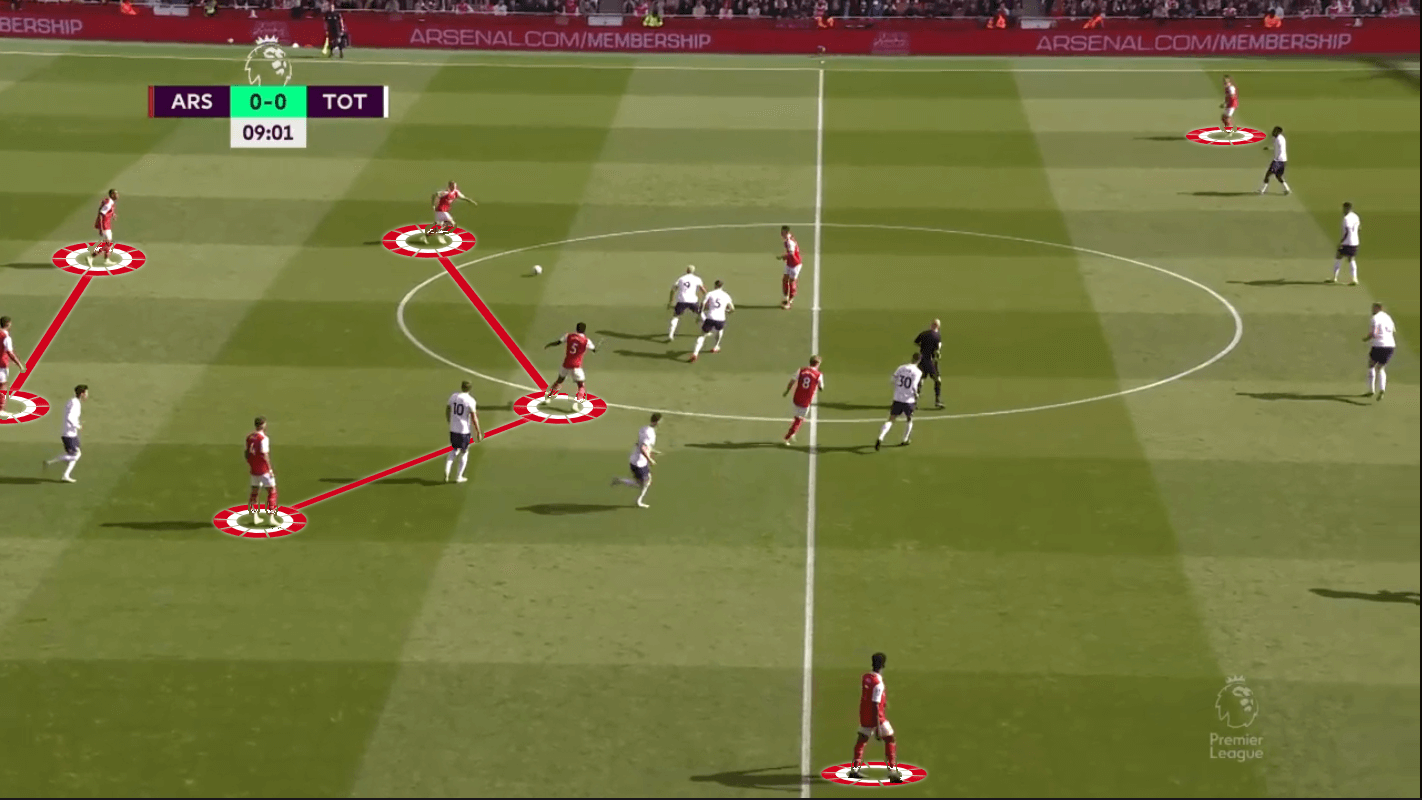
You can see how the 2-3 build-up attracts Tottenham’s players into the centre of the pitch and consequently disrupts their defensive shape. It pulls the wide players narrower which creates space out wide. It triggers the central midfielders to push higher creating more space between the lines and it allows Arsenal wides players Saka ad Martinelli to be 1v1 with Tottenham’s wingbacks, pinning them back into their defensive line.
Attacking Shape
When Arsenal attacks in a 2-3-5 shape, the 2-3 structure in the build-up phase becomes the 3-5 structure as they progress into the final third. The three-man midfield allows Arsenal to control the space centrally and the five-man attacking line overloads the other team’s defence as the team attacks the penalty area.
You can see in the image below how the midfield three support the attacking line. In possession, it supports the positional play approach used by Arteta as it gives Arsenal full coverage of the pitch as they enter the attacking third. Arsenal has at least one player occupying both wide channels, the central channel and each of the half spaces.
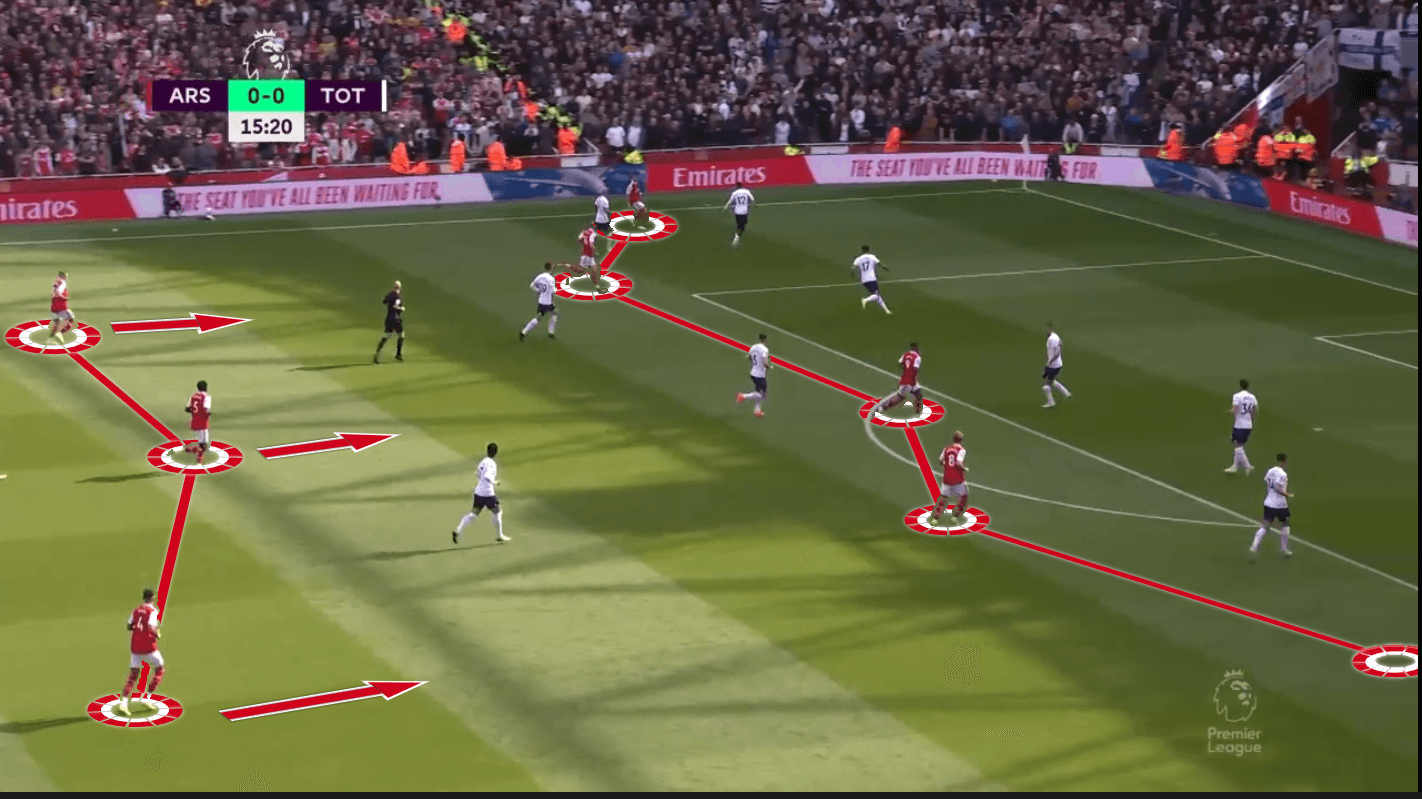
Out of possession, it enables Arsenal to defend high up the pitch and protects them against quick transitions if there is a turnover in play.
The next two images show the superiority the shape offers out wide and centrally and how easily the shape can rotate with simple movements to support the ball carrier.
The first shows how Arsenal overload the pitch centrally with six players. With White and Zinchenko acting as inverted full-backs and creating the three-man midfield we discussed earlier, it allows Arsenal to control the space both in behind and in front of their opponent’s midfield.
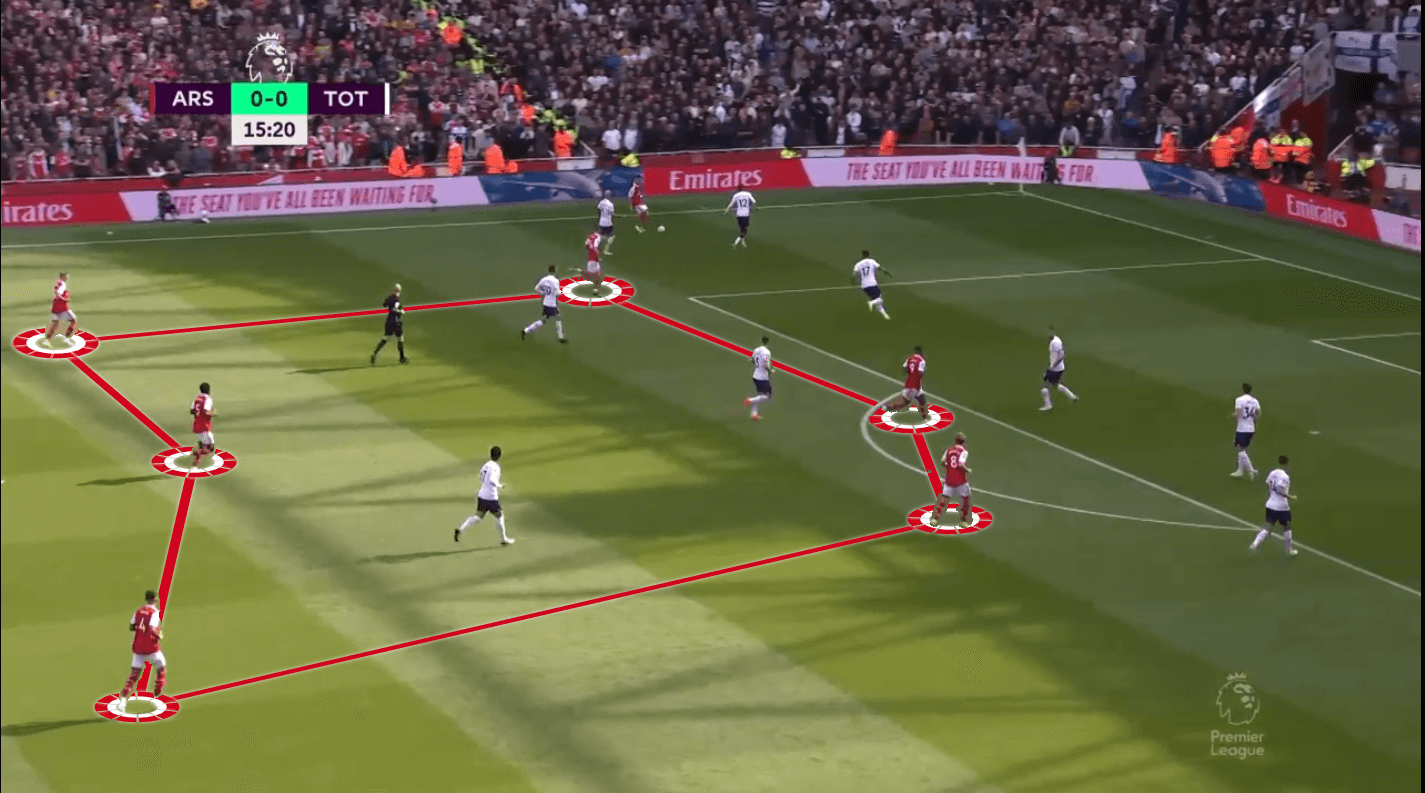
The second image shows how one simple five to ten-yard movement towards the wide area from either Ben White or Oleksandr Zinchenko, enables the team to switch their focus to overloading wide areas.
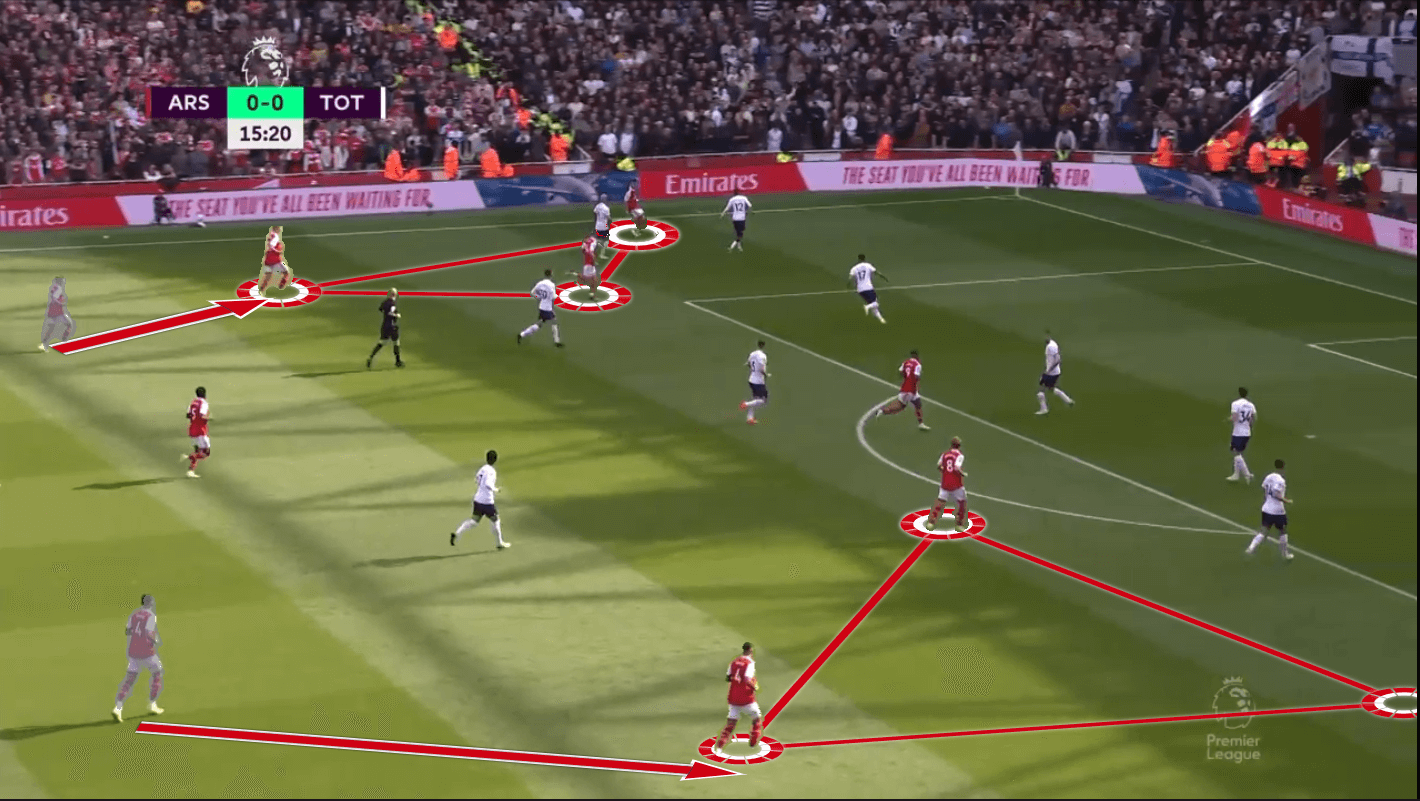
To be able to move and rotate positions without compromising your attacking shape is crucial to being effective when applying positional play.
Overall, Mikel Arteta will be happy with how effective his team are in attack. They average the joint highest number of shots on target per 90 minutes with Manchester City and Liverpool with 7 shots.
Out of those shots, they are achieving an xG rate of 2.1 per 90 and are scoring 2.6 goals per 90 which are the second-highest in the league behind Manchester City. Whilst they are overperforming with their goals scored, they are not overperforming at an alarming rate. They are creating good goal-scoring opportunities in each game.
Free number eight’s
Having the 2-3 structure set with fullbacks coming inside allows the two central midfielders to push forward and become influential in the attacking line. For Arsenal, the two players tend to be Granit Xhaka and Martin Odegaard.
Both players have been given the freedom by Mikel Arteta to go and be influential in the second build-up phase and the final third. The movement and the positions they occupy have been key to how well the team’s transition to the 2-3-5 attacking shape
The heat map for both players below shows the areas they have completed most of their actions in. You can see how Xhaka completes most of his actions in the left-hand half space and left-hand channel. Odegaard completes most of his actions in the right-hand half space.
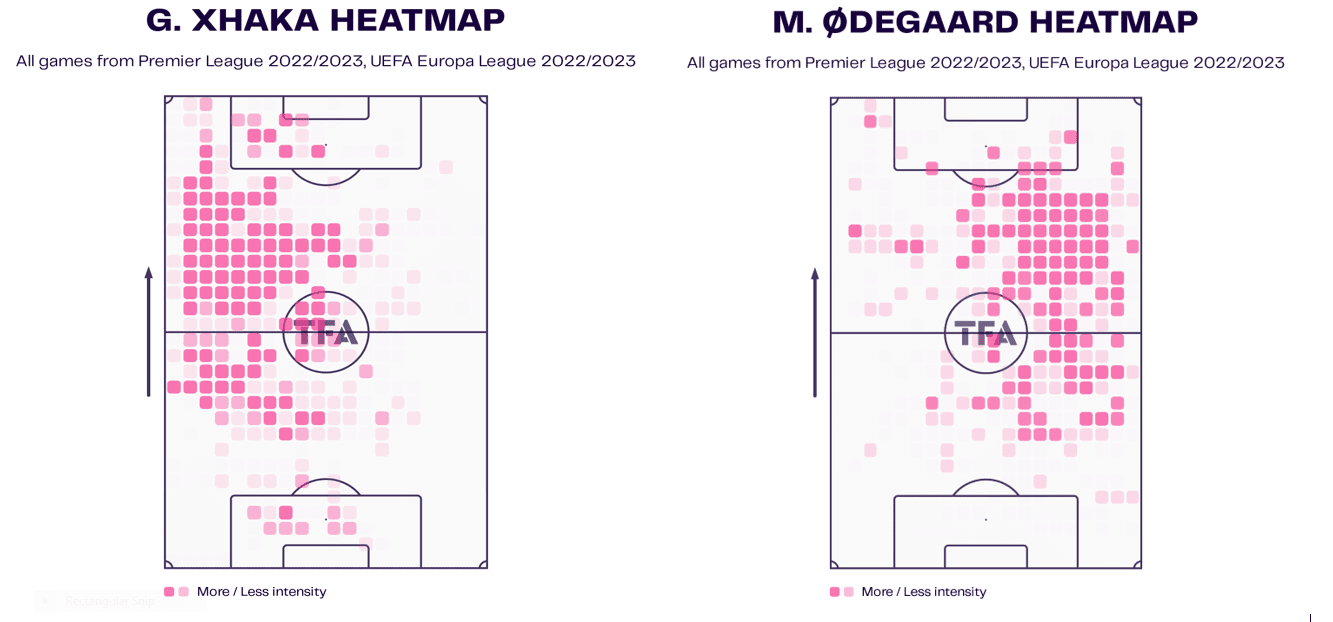
You can see in the image below the position and role, they play in the 2-3-5. This is Arsenal building up through the middle third and looking to progress through to the attacking third. Xhaka and Odegaard have taken their prime position on either side of Gabriel Jesus, completing the five-man attacking line. They must join the attacking line at this stage of the attack.
As the fullbacks come inside and sit narrow, it is the responsibility of Martinelli and Saka to make sure they stay out wide and provide the team with width. If Xhaka and Odegaard or anyone else playing in that position did not move into this space, then Gabriel Jesus or any other striker would become isolated.
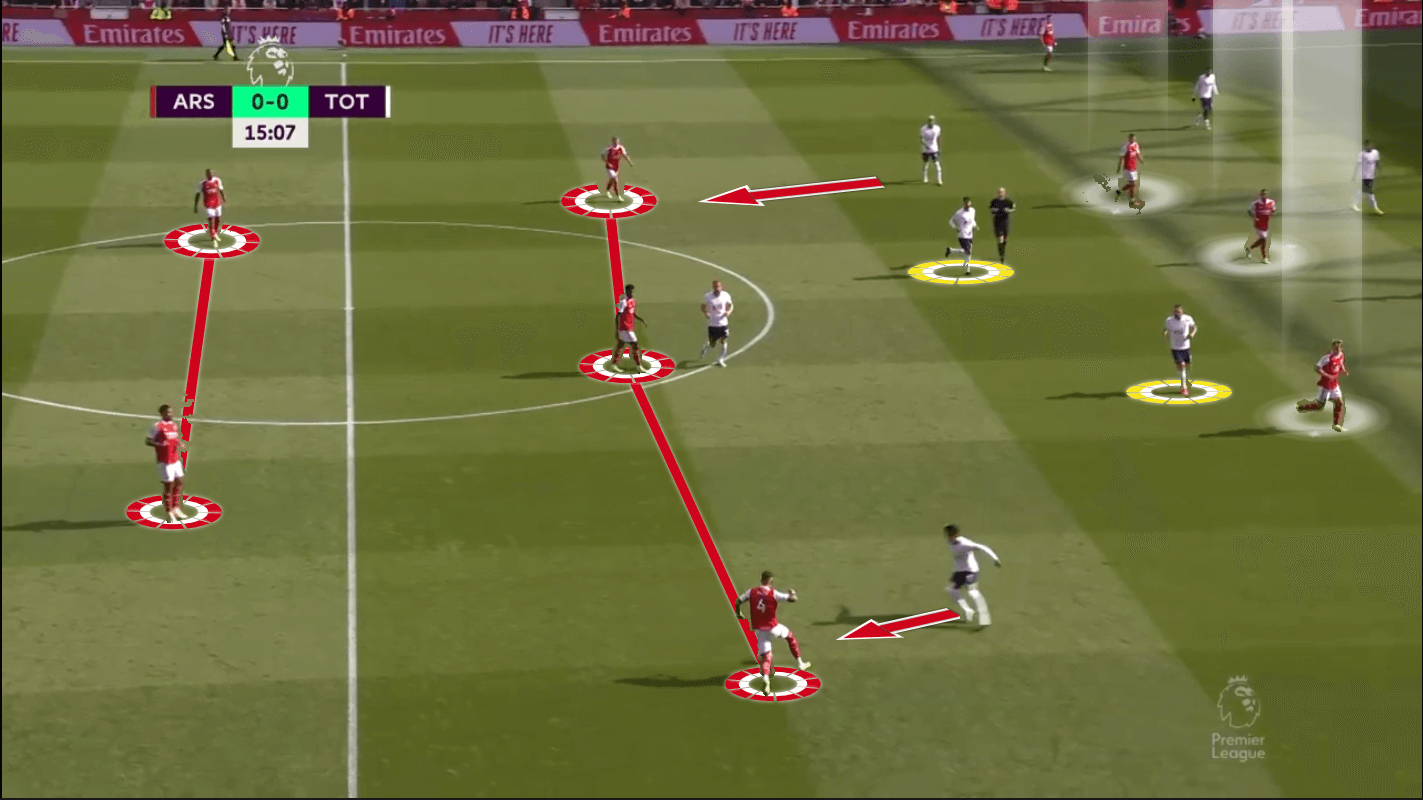
Xhaka and Odegaard’s position is not only key because they are between the lines, but also because of the spaces that surround them which they can choose to exploit.
As each heat map shows both players tend to move into the wide channels which in this passage of play would create a 2v1 overload against Tottenham’s full-back.
Neither of Tottenham’s wide players can drop back because the three-man midfield has pulled them inside to stop the build-up and the central midfielder following the run out wide as that would mean leaving a big space in the centre for Arsenal to attack.
Counter Pressing
The 2-3 structure within the attacking shape provides defensive benefits as well and it allows Arsenal to have five players ready for their opponent’s counterattack and forces any counterattack out wide, further away from their goal.
As their attacking approach consists of holding possession and playing high up the pitch as possible their first response to losing possession is to stop quick turnovers and counterattacks through counter-pressing. If that press is beaten or they do not win the ball immediately then they fall back into a defensive shape and apply a man-oriented press dependent on the area of the pitch the ball is held.
Arsenal’s pressing efficiency this season stands at 55% and is the fourth-highest in the league. Although they are not one of the highest in the league for recoveries in the opposition’s half per 90, they are only two behind the highest as the chart below shows.
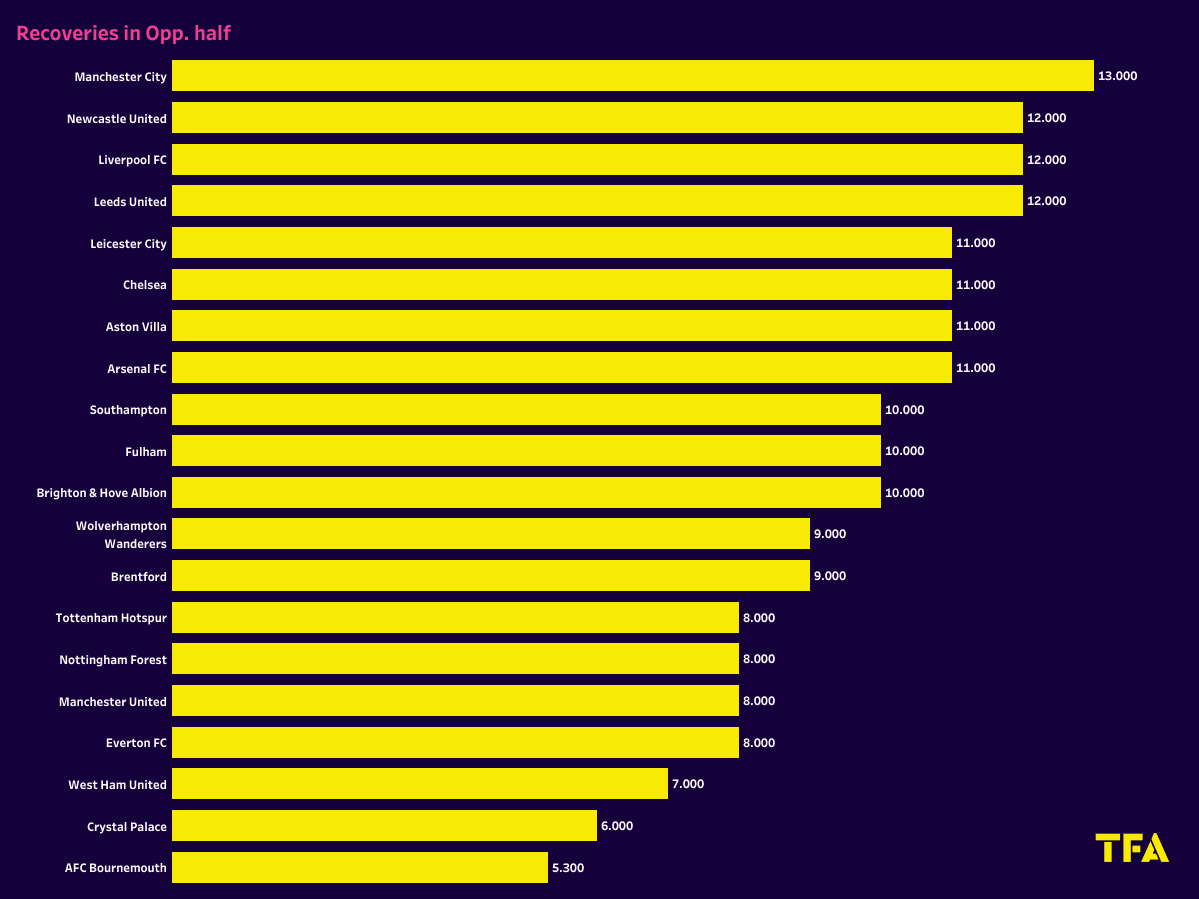
Defensive Blocks
Arsenal defends high up the pitch to prevent the opposition from being able to progress the play. The defensive shape they defend in resembles that of a 3-2-3-2 shape or a hybrid 3-5-2 shape. The reason for this is so that they can funnel the opposition play down one side.
This example shows Bukayo Saka coming inside to create a front two with Marin Odegaard pushing forward to create a second defensive line with Ben White and Gabriel Martinelli. Jesus and Martinelli are starting to pressure on the ball.
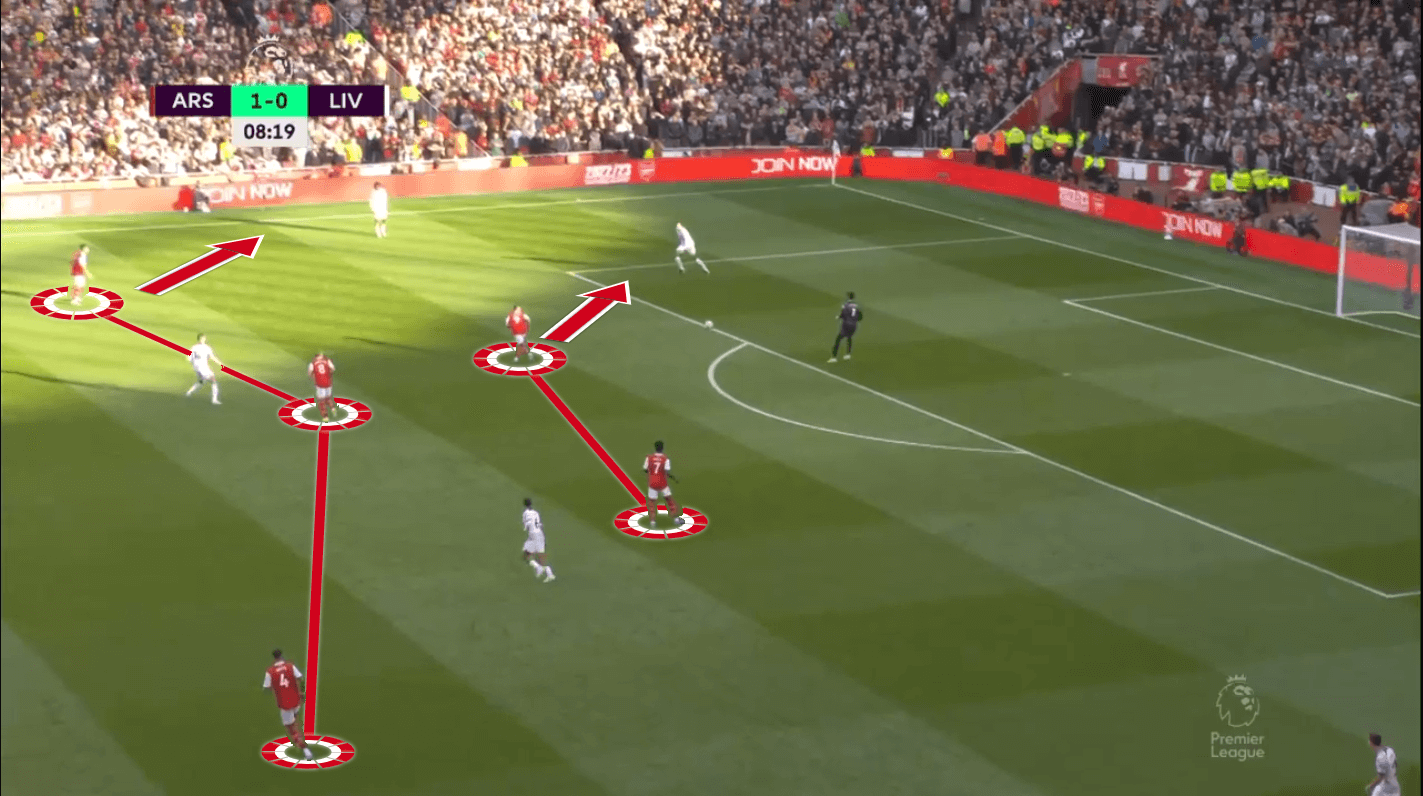
Ben White pushing up on the far side allows the Saka to move inside. If White did not push up Arsenal would become vulnerable to a switch of play during this phase. This would make their high block too easy to play through. Instead, Arsenal can aim to condense the space on the ball side.
Arsenal’s defensive set changes are dependent on what area of the pitch the opposition has the ball. Once the opposition progress further than their defensive third, then Arteta prefers his team to drop into a 4-4-2 mid-block and a 4-4-2 low block.
The team then look to maintain a compact shape and look to cut off the centre of the pitch and force the opposition wide. Their pressing approach from this stage is intense and aggressive. However, it is a man-orientated press, meaning the players will press intensely and quickly once the ball enters their area of the pitch whilst the rest of the team maintains its shape.
The next two images show Arsenal’s mid and low blocks as they look to stop the play from going beyond their middle third and into their penalty area.
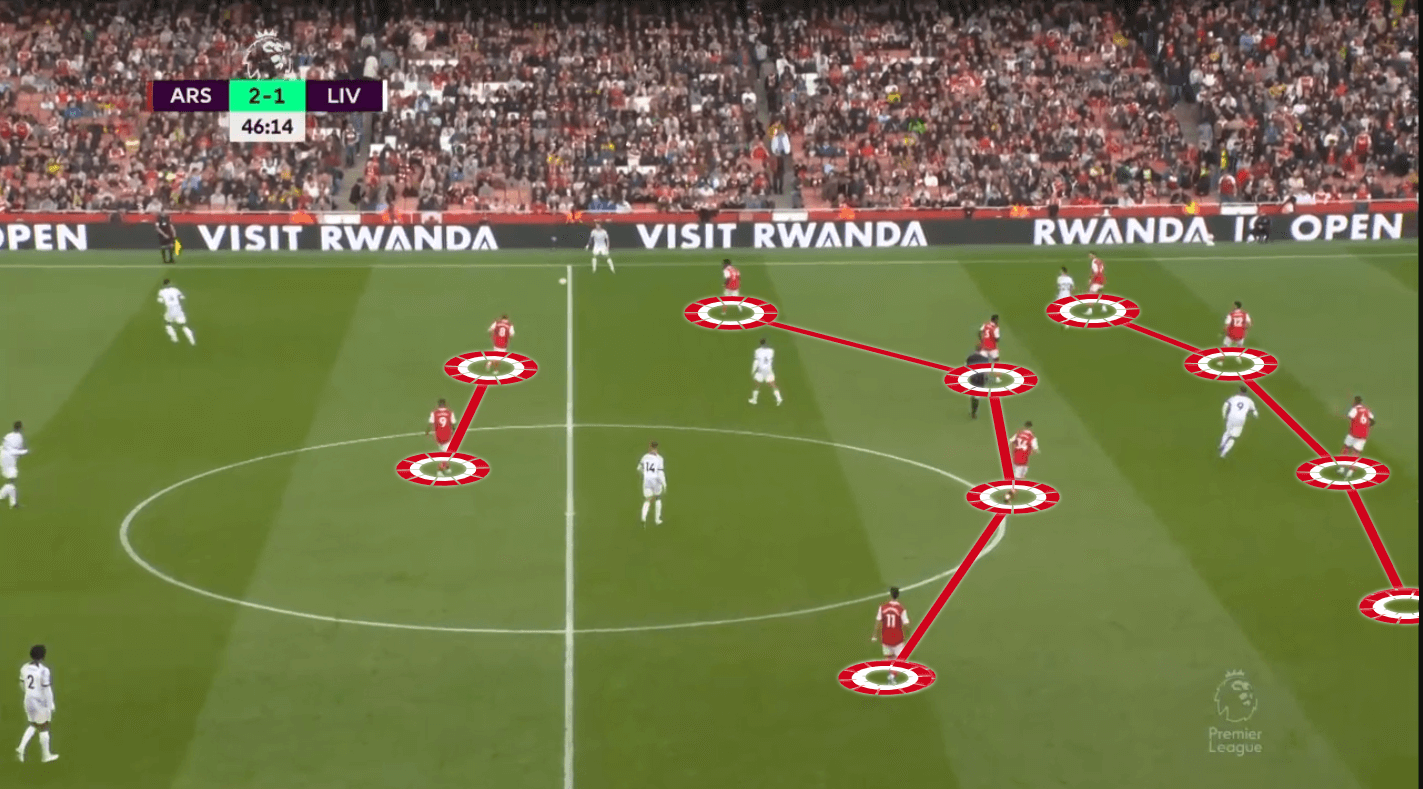
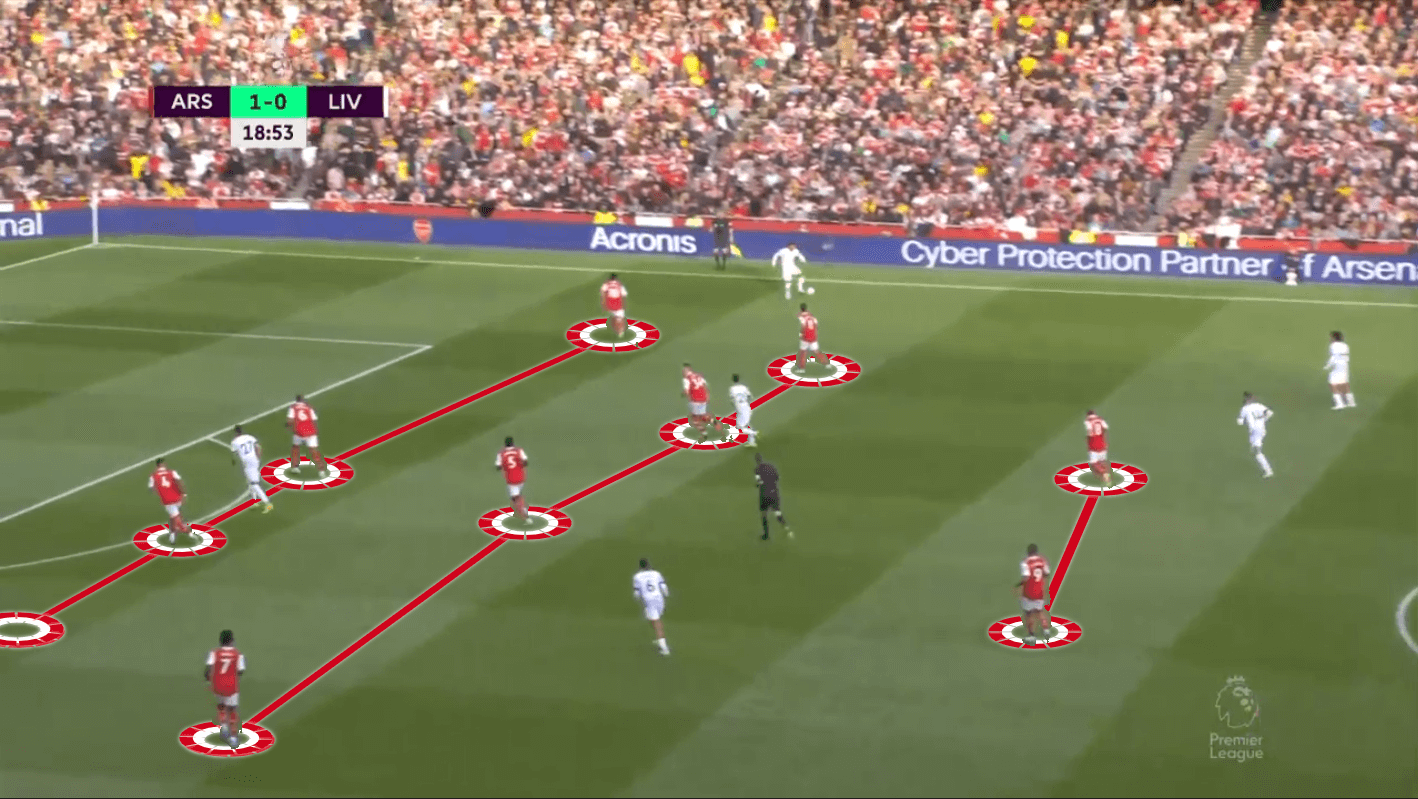
Conclusion
With many people predicting Arsenal to be in the battle to finish in the UEFA Champions League places, currently being in first place and keeping pace with Manchester City will be a bonus and a challenge the fan base will be enjoying. Even though the Gunners winning the league is unlikely, you would not bet against Arteta building on his team’s FA Cup triumph in 2020 as they still have both domestic trophies and the Europa League to compete in this season.
This is a tactical analysis in the form of a scout report that focuses on Arsenal’s tactics this season, and the impact they have had on their current run of form. We have provided an analysis of the tactical traits within the team’s attacking stages, along with key aspects of their defensive structure.






Comments